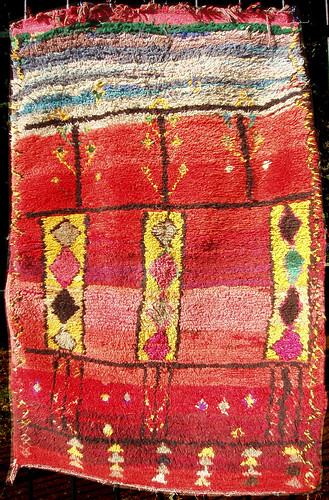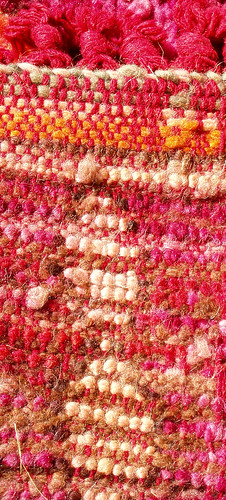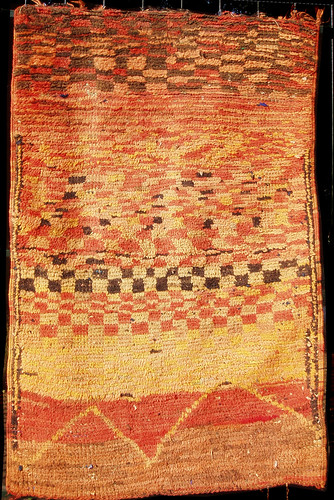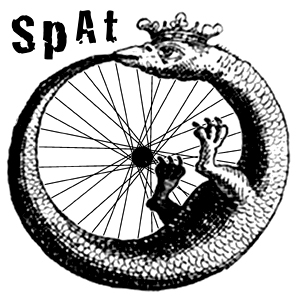My paper for:
Jacquard loom in contemporary textile art and education
International Symposium
Fondazione Lisio Arte della Seta
Firenze 19 - 24 Luglio 2007
There are more things in looms and fiber, Horatio
Than are dreamt of in your philosophy.
Almost Shakespeare, Hamlet, Act I
 Even in the most serious Shakespearian plays, a clown may come on stage. Such an illustrious precedent justifies my participation in this undoubtedly serious conference. I will try to draw your attention to the “ignoble” (i.e. “non-noble”) origins of textile design through modern technology and to the mix-up between painting and weaving. I rely on my thirty-years of experience as a hand weaver, on the art history, on a handful of psycho-physiological data and on some tribal rugs on which not only I rely but I also lie on with pleasure. My contribution may be concentrated into three points:
Even in the most serious Shakespearian plays, a clown may come on stage. Such an illustrious precedent justifies my participation in this undoubtedly serious conference. I will try to draw your attention to the “ignoble” (i.e. “non-noble”) origins of textile design through modern technology and to the mix-up between painting and weaving. I rely on my thirty-years of experience as a hand weaver, on the art history, on a handful of psycho-physiological data and on some tribal rugs on which not only I rely but I also lie on with pleasure. My contribution may be concentrated into three points:1-Weaving is NOT what you think it is
2-Weaving is what you do NOT think it is
3-There is NO thought without weaving
I will support these arguments by having recourse, eventually, to one famous devil’s advocate, that is, Mephistopheles.
My blog opens with the following phrase: “I am a weaver but it's not what you think it is”. So I resort not only to Shakespeare to justify myself but also to the classic excuse of the husband who has just been caught in bed with another woman:” Don’t worry, darling. It’s not what you think”. What a poor excuse! In my case , it’s quite true…..but not only in my case, fortunately! Certain weaving is really not what you think it is: it is not traditional craftwork nor art. The term “Art” has uncertain and historically variable meanings. For example, in Italy weaving is still considered a decorative or applied art and this implies the existence of other art forms, fine arts to be precise. Of course, Italian fiber art aspires to be admitted to the fine arts “club” with all the advantages offered. Frankly speaking, I might have been interested myself: as there were no teaching posts available, I’ve had to create a specific “Faculty of Weaving”. You can imagine how tiring it is to be the dean….!
Getting back to that phrase on my blog, I was talking about art in general. In fact, the most frequent compliment I receive is: “Your work is art, not craftwork!”. Art…what does it mean? Its most common meaning is: “the expression of an inspired drawing through “artistic” techniques”. So, there is an inspiration that takes the form of a drawing . The artist transfers this mental drawing to paper and transforms it into a work of art through the (artistic) techniques at his/her disposal.
 On the contrary, certain weaving is what you do NOT think it is. The thought is there, it is ineliminable but also inessential: weaving/art is always somewhere else. Where? In the concrete act of weaving. There is no weaving without threads, just like there is no music without sounds (2). If the spirit resides out of bodies and matter, these are simply dead. A mystic? An animistic? Perhaps, but I am in good company, with humble and simple weavers.
On the contrary, certain weaving is what you do NOT think it is. The thought is there, it is ineliminable but also inessential: weaving/art is always somewhere else. Where? In the concrete act of weaving. There is no weaving without threads, just like there is no music without sounds (2). If the spirit resides out of bodies and matter, these are simply dead. A mystic? An animistic? Perhaps, but I am in good company, with humble and simple weavers.Give a look at these Moroccan rugs, woven in the tribal area of Boujad. Don’t waste your time by searching for symbols or meanings. As said above, these are inessential. Many researchers have tried and have come to the conclusion that there are symbols in traditional weaving but they are unconscious. That is to say, weavers unconsciously follow predetermined drawings, exactly as spiders do. By the way, have you ever seen two perfectly identical spiderwebs?
It now remains to distinguish between shape and shaping. A shape is a drawing in space, a symbol, an icon. An example of shape is a roadsign consisting of a red-rimmed white triangle bisected by a black stripe which means “danger, be careful”. Shaping is instead a process, an operation, an action taking place in Time. A rug weaver ties knots, one after another in a row along the weft. Then he ties the knots on the following wefts until he fills up the whole fabric. A knot is like a point, a row of knots a line and the whole rug, a surface. We can thus analyse the rug from a geometric point of view, identifying, classifying and taking a census of every shape existing on a territory and occupying a space. What about shaping in time? Is it the mere manual labour of weaving? I believe not.
Every knot marks a point. It is a colored exclamation mark destined to become a question mark compared to the upper row of knots. This colored mark can be isolated or ignored or become the founder of a new lineage along the warp. Or instead it can generate two divergent lineages that will unite again in another weft. That is how we obtain a rhomb. The mother vagina of the great goddess? Very well, then…let’s not talk about it anymore. However, personally speaking, I’m more excited by the pile: chromatic molecules that aggregate and separate in the manual process of shaping. Chaos? Improvisation? Or rather, gestures in syntony with instruments and material. Or instead, psycho-physiological interaction between the Subject and the World. If artistic creation exists, it is here, rather than inside a thought designing an abstract shape.
Even the most spiritual inspiration, the most intellectual and modern thoughts are descended from manual gestures, the ancestral gestures of the first weavers or basketmakers. They still are the structural elements of our neural fibers and system, including syntactic structure and logical connections. Psycho-physiologists demonstrate that every creative act taking place within our cerebral cortex is accompanied by a micro-gesture of our body. For example: we cannot picture a galloping horse without moving our eyes (3). Maybe one day we will be able to analyse the micro-gestures of a philosopher while lecturing or Wittgenstein’s gesticulation during his famous performances at home. Consequently, hand-weaving is good for not only the mentally disabled but also for the Computer Assisted Designer. It is not only a technical experience (which would prevent many technical mistakes), but also art. It would be good for philosophers as unfortunately university teaching staff have no textile experience. The Western school system is not like the Ewe people’s, for whom weaving is a compulsory subject: His Majesty Togbui Addo VIII is a mathematician from Oxford University but his subjects admire him for his weaving skills (5).
 And those Moroccan rugs? Besides all the symbols and meanings, they represent an abstract art form, that is, concrete weaving. Aren’t they beautiful enough? The true rug expert is the souk shopkeeper. He cannot extol a rug's knot density, precious wool or dyeing: these rugs are quite poor, rags are used to make the weft. So he will merely say that the rugs are works of modern art: “Regardez: un tableau de Picasso!”. Actually, there are so many precious collections.
And those Moroccan rugs? Besides all the symbols and meanings, they represent an abstract art form, that is, concrete weaving. Aren’t they beautiful enough? The true rug expert is the souk shopkeeper. He cannot extol a rug's knot density, precious wool or dyeing: these rugs are quite poor, rags are used to make the weft. So he will merely say that the rugs are works of modern art: “Regardez: un tableau de Picasso!”. Actually, there are so many precious collections.Not only textile researchers have developed an obsession about symbols: many professors share this same bad habit. It is called iconology and derives from the supremacy that painting has always had over all other art forms, in particular over weaving. Weavers have been regarded as copiers (at best) of the creative design by the “true” artist, that, is, the painter. Our reputation has been damaged by the Renaissance and not only ours: it damaged art and life in general (6). Luckily, neither Boujad nor Islamic art were influenced by the Renaissance. But they are Berbers….in short, barbarians.
We civilized people, instead, want to know the artist’s intent, the painting’s meaning. I once met an art teacher who never went beyond the Impressionist movement because, after that, he found no more figures having a meaning. Nonetheless, he became a councillor in charge of cultural activities and then, as a mayor, he had to inaugurate a contemporary art park: the Giardino di Daniel Spoerri. However, that Giardino is as full of meanings as a Rorschach’s blot.
In conclusion, they have searched so long for meanings that, in the end, they convinced some artists to create a meaning without wasting too much time on the work of art. Even artists have to get by and art gallery owners as well. This is the famous conceptual art in which the most important thing is the artist’s “Concept”.
We began with Shape and Meaning, we proceeded to the Concept, from which we return to textile arts. The term 'concept' has gynaecologic roots: to conceive, conceived, conception. It seems a bit strange that female fiber artists have devoted themselves to conceptual art. Especially those who claimed textile art’s ancestral femininity. Actually, they wanted to do the contrary: they wished to procreate in an immaterial way, just like the intellectuals have always done, following a male and bachelor tradition. Academic culture has clerical origins. Only one century has gone by since members of Oxford have been allowed to get married. That is why bachelor means both a graduate and an unmarried man. So, firstly clergymen and alchemists, then academicians and scientists have pursued a male “Immaculate Conception”, an inveterate misogynous desire (7). In brief, fiber art gave life to the off-loom (weaving fibers without a loom) and then to the off-fiber (fiber art without fibers).
However, man cannot live on concepts alone: even the Portrait wants its share: of course, its share of conceptual art. In fact, today there is no need to use a brush to depict the soul of a face, nor to frame it. Not even jacquard weaving requires a draft anymore. You just need a photo and a Photoshop program. The design is woven on an electronic loom. But doesn’t a loom, tribal or jacquard, have a body (or soul of its own) ? Shouldn’t it express it with each and every fiber? As Shakespeare has it: “There are more things in looms and fiber than are dreamt of in your philosophy”. Furthermore I would like to say, and without copying the original text this time: let’s never forget the textile origins of that same philosophy.
Mephistopheles
In truth the subtle web of thought
Is like the weaver's fabric wrought:
One treadle moves a thousand lines,
Swift dart the shuttles to and fro,
Unseen the threads together flow,
A thousand knots one stroke combines
Then forward steps your sage to show
And prove to you, it must be so;
The first being so, and so the second,
The third and fourth deduc'd we see;
And if there were no first and second,
Nor third nor fourth would ever be.
This, scholars of all countries prize,--
Yet 'mong themselves no weavers rise.
(Wolfgang von Goethe, Faust, Act I) (8)
-------------
 1) http://lucianoghersi.blogspot.com
1) http://lucianoghersi.blogspot.com2) Vezio Ruggieri, "L'esperienza estetica: Fondamenti psicofisiologici di un'educazione estetica". 1997.
3)Vezio Ruggieri, "The running horse stops: the hypothetical role of the eyes in imagery of movement". In "Perceptual and motor skills." 1999. In: "L'identità in psicologia e teatro. Analisi psicofisiologica della struttura dell'io." Second reprint 2005.
4) LG, "La tessitura o del ritrovare se stessi", in Arti Terapie (June 2006, Rome)
Silvia Micocci, "la tessitura a mano in una prospettiva arteterapeutica", "tessereAmano, October 2002"
5) LG "Piedi che aprono, mani che battono"
6) Mario Perniola, "L'alienazione artistica. 1971.
7) David F. Noble, "A World Without Women: The Christian Clerical Culture of Western Science". 1992.
8) "The subtle web of thought", in the first line, is an incorrect translation of the German "der Gedankenfabrik". "Fabrik" is a false friend of fabric" but it means "factory". So "thought factory" and without "subtle".







No comments:
Post a Comment